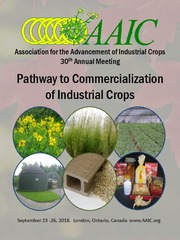| dc.creator | Zanetti, Federica | |
| dc.creator | Marjanović-Jeromela, Ana | |
| dc.creator | Vollmann, Johann | |
| dc.creator | Righini, Daria | |
| dc.creator | Borghesi, Arianna | |
| dc.creator | Cvejić, Sandra | |
| dc.creator | Monti, Andrea | |
| dc.date.accessioned | 2021-11-16T08:26:53Z | |
| dc.date.available | 2021-11-16T08:26:53Z | |
| dc.date.issued | 2018 | |
| dc.identifier.uri | http://fiver.ifvcns.rs/handle/123456789/2433 | |
| dc.description.abstract | Camelina [Camelina sativa (L.) Crantz] is a native species of Europe where it was widely cultivated until the beginning of the 19 th century, afterward replaced by more productive species such as oilseed rape (Brassica napus L.). The recent renaissance of this species is mainly due to its wide environmental suitability, low input requirements and good tolerance to pests and diseases. The majority of breeding programs for this species is located to northern America and northern Europe, while a real evaluation of new camelina genotypes suitable for southern Europe is just recently started within a common research program enclosing two breeding groups (IFVCNS and BOKU) and one group focusing on the agronomy (DISTAL). In spring 2018a twinned experiment comparing 2 camelina lines selected by IFVCNS (NS Slatka and NS Zlatka) and 6 lines selected by BOKU (CA13X_1S-21, CJ6X-78, CK1X-129, BGRC51558, CU005 and CJ13X-115) was set up at Bologna (Italy, 44°30’ N, 11°21’ E, 28 m a.s.l) and Rimski Šančevi (Serbia, 45°20’ N, 19°51’ E, 84 m a.s.l). The trial was arranged as a randomized complete block design with three replicates. The experimental protocol in terms of plot size, seeding rate and agronomic management was the same in the two locations, while sowing date was optimized according to local environmental conditions. Different earliness among tested spring camelina lines was highlighted in Bologna, with line CJ13X-115 showing a significant delay both in flowering and maturity stage compared to all the other lines. Due to sub-optimal weather conditions in Bologna (i.e. high temperature and exceptional wetness during spring) disease pressure resulted quite high and some camelina lines were more susceptible to downy mildew (Hyaloperonospora camelinae) than others, this trait needs to be better investigated with future specific experiments. The high susceptibility of camelina to dodder (Cuscuta sp.) has been confirmed with a massive infestation of this parasitic plant in Bologna trial this year. White rust (Albugo candida) and Hyaloperonospora camelinae were dominant diseases in Serbia affecting all genotypes by mid-June, which clearly impaired plant growth and yield formation. The full characterization of tested camelina lines in terms of seed and biomass yield, plant height at harvest and seed quality will be also presented aiming at an exhaustive characterization of these new spring camelina genotypes | sr |
| dc.language.iso | en | sr |
| dc.publisher | Association for the Advancement of Industrial Crops | sr |
| dc.rights | openAccess | sr |
| dc.rights.uri | https://creativecommons.org/licenses/by/4.0/ | |
| dc.source | Program and Abstracts, International conference "Pathway to Commercialization of Industrial Crops", 30th Annual Meeting of the Association for the Advancement of Industrial Crops (AAIC), 23-26 September 2018, London, Canada | sr |
| dc.subject | Camelina sativa (L.) Crantz | sr |
| dc.subject | experimental protocol | sr |
| dc.subject | new genotypes | sr |
| dc.subject | southern Europe | sr |
| dc.subject | camelina | sr |
| dc.title | Preliminary evaluation of new camelina genotypes suitable for southern Europe | sr |
| dc.type | conferenceObject | sr |
| dc.rights.license | BY | sr |
| dc.citation.epage | 88 | |
| dc.citation.spage | 88 | |
| dc.identifier.fulltext | http://fiver.ifvcns.rs/bitstream/id/6635/bitstream_6635.pdf | |
| dc.identifier.rcub | https://hdl.handle.net/21.15107/rcub_fiver_2433 | |
| dc.type.version | publishedVersion | sr |


